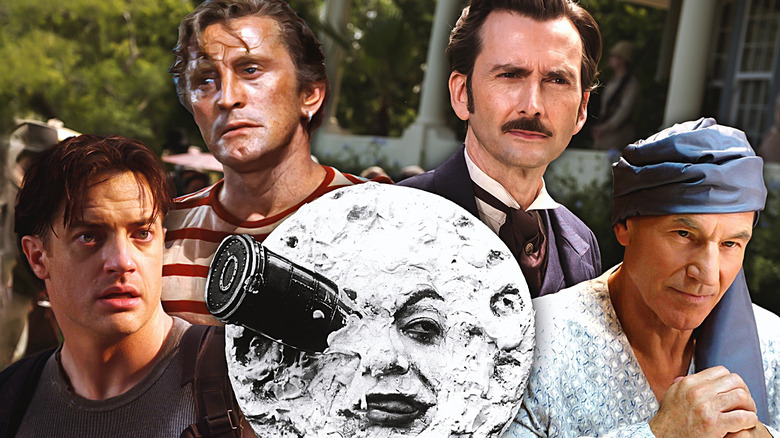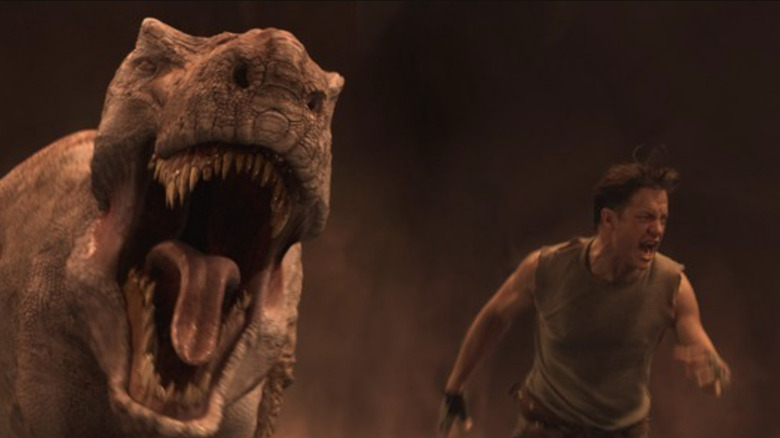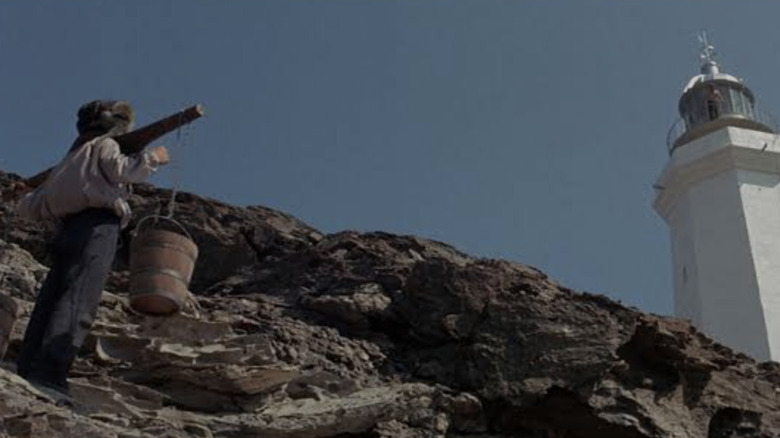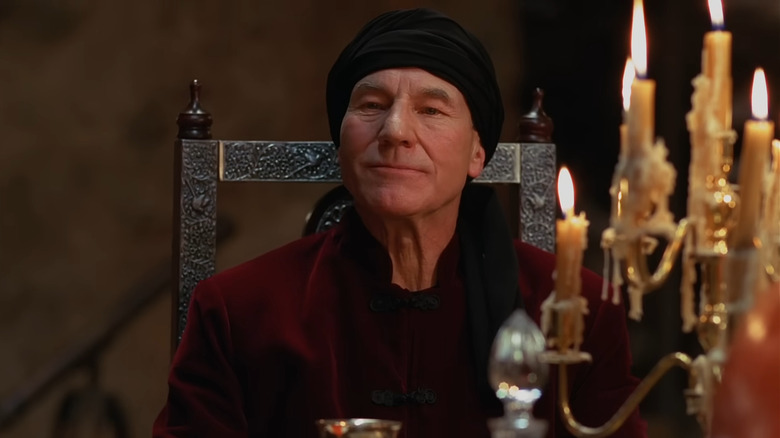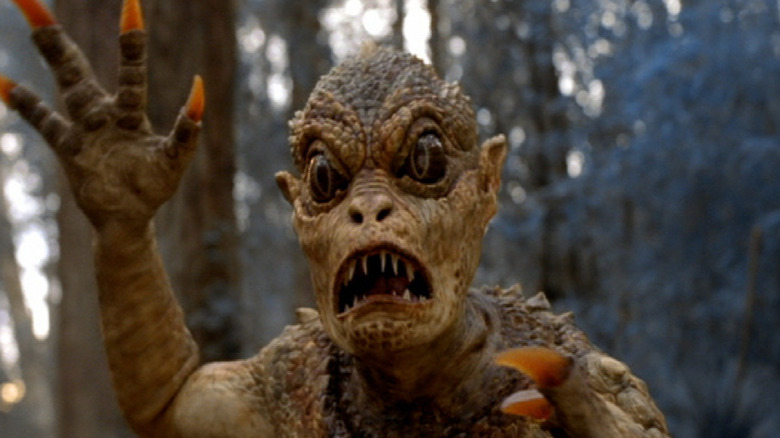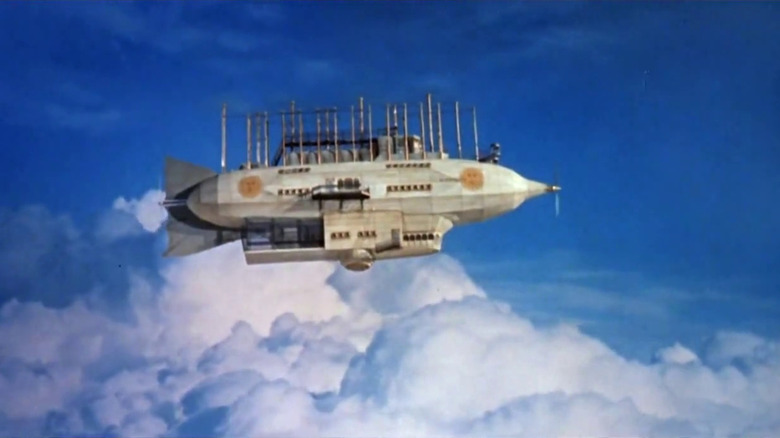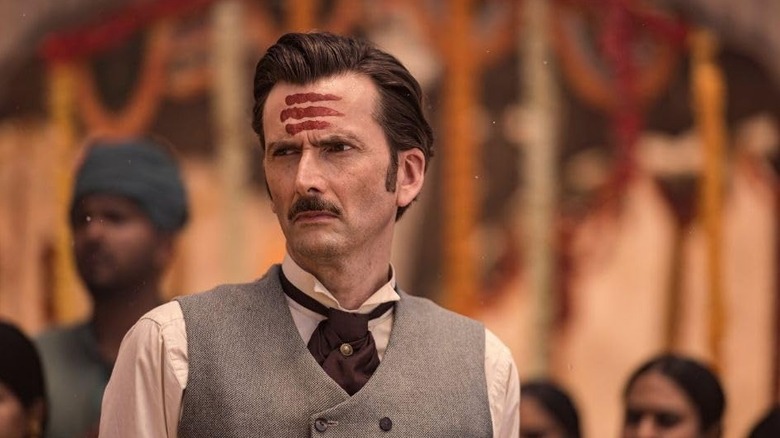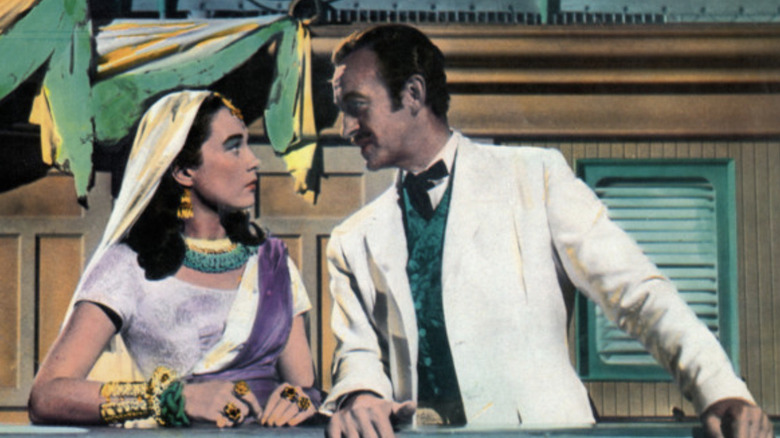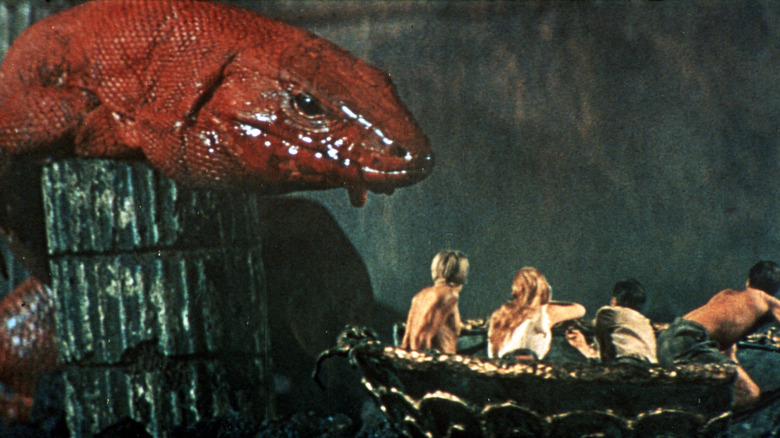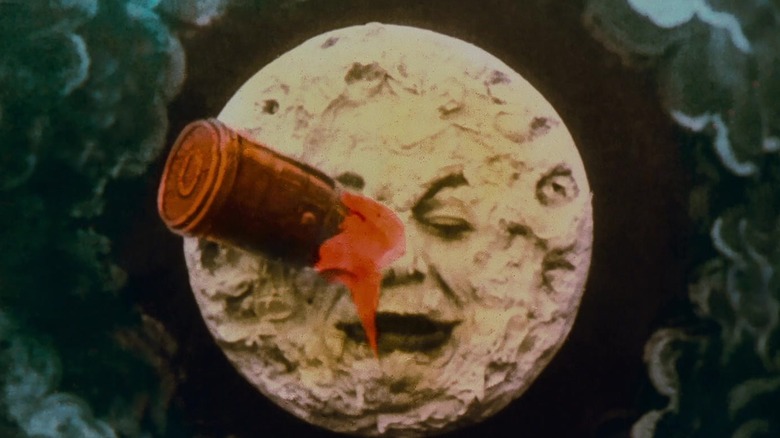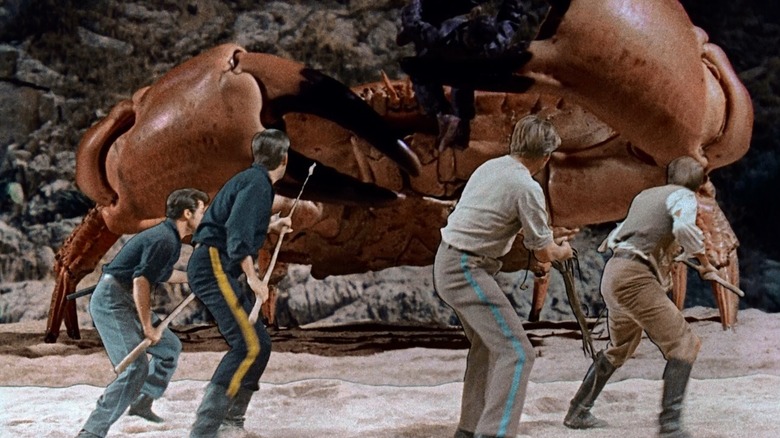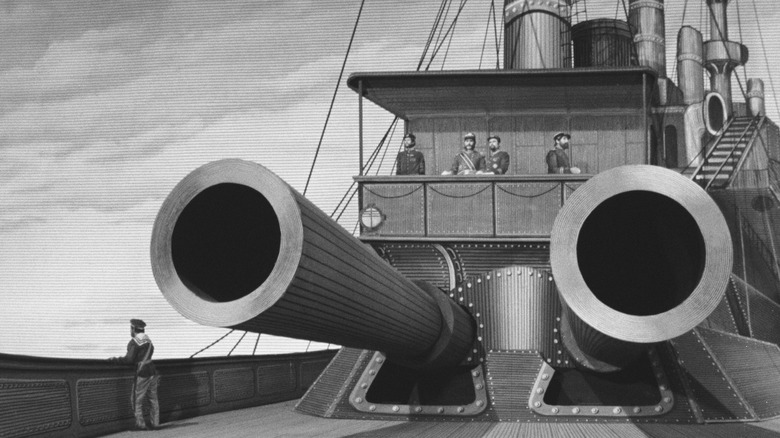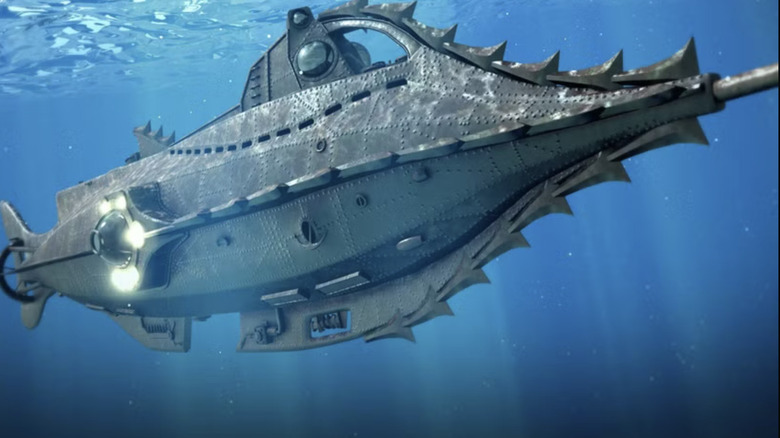The 12 Best Movies And TV Shows Based On Jules Verne Books, Ranked
Born in Nantes, France in 1928, Jules Verne was sent to Paris as a young man to study law, but fell in love with theatre. He wrote several plays, got married, worked as a stock broker, and continued to write on the side. Eventually, Verne had an epiphany: What if he combined his twin passions of adventure stories and scientific inquiry? You might say this was a "novel" concept in the mid-1800s. Verne's vision was realized when a publisher agreed to print Verne's "Voyages extraordinaires—Cinq semaines en ballon" ("Extraordinary Journeys: Five Weeks In A Balloon") in 1864. The serialized story became a bestseller, so Verne quit his job, writing "science fiction" for 40 years until his death in 1905.
"Extraordinary journeys" doesn't have the same ring as "sci-fi," but Verne is often called the "father of science fiction". Considering sci-fi stories dominate narrative storytelling, Verne can be considered the grandaddy of "Star Wars," "Star Trek," "Avatar," superheroes, and the list goes on. While Verne inspired essentially every sci-fi story ever, we're only going to look at those based on his books. While these adaptations may not be better than their source material, each shows how Verne inspired generations of storytellers, and continues to do so today. You don't have to plunge 20,000 leagues beneath the sea, travel the world in 80 days in a balloon, or even crack open a book to discover Verne's brilliance. Just check out the 12 best movies and TV shows based on his books!
12. Journey To The Center of the Earth (2008)
Brendan Fraser's 2008 was his last big, tentpole-fueled summer before the "Brendan Fraser Renaissance" revitalized his career more than a decade later. One of his two hit films was "The Mummy: Tomb of The Dragon Emperor," which despite its well-earned reputation as being a terrible movie that killed "The Mummy" franchise actually made about as much as its predecessors. The other hit was a bit surprising: an adaptation of Jules Verne's "Journey To The Center of the Earth." "Journey" opened surprisingly strong at $21 million and despite "The Dark Knight" dominating the summer managed to leg it out to $243 million worldwide, making it a bonafide success story with a $45 million budget.
Turns out moviegoers really liked seeing Fraser in a family friendly, PG-rated adventure film featuring dinosaurs. In this loose adaptation of Verne's 1864 novel (and I do mean "loose"), Fraser plays Prof. Anderson, who gets trapped in a cavern with his nephew (Josh Hutcherson) and guide (Anita Briem) that leads them deep below the Earth's surface to a place of incredible creatures, including a T-rex and other dinos. Fraser's wholesome charm keeps "Journey" from descending into face-slapping silliness, making it an easy, breezy watch. Shame Fraser was out for the 2012 sequel, "Journey 2: The Mysterious Island," passing the baton to his "Mummy Returns" co-star Dwayne Johnson.
11. The Light at the Edge of the World
Jules Verne wrote "The Lighthouse at the End of the World" in 1901, though the edited novel wasn't published until after his death in 1905, while the unaltered manuscript didn't see the light of day until nearly 100 years later in 1999. In between was a fine film adaptation starring Vernes' veteran Kirk Douglas ("20,000 Leagues Under The Sea") and Yul Brynner, the multitalented star of such diverse films as "The King & I," "The Magnificent Seven," and "Westworld."
In the 1971 film, Brynner shivers timbers as a pirate who captures a lighthouse in the southernmost point of Argentina in 1865. Only the lighthouse keeper (Douglas) can stop the ruthless buccaneer from using the lighthouse as a weapon to cause passing ships to crash onto the rocks so that he can pillage and plunder them. The film changes Vernes' title from "The Lighthouse at the End of the World" to the more gritty and gripping "The Light at the Edge of the World," which is apropos. While under-appreciated in its day, and under-seen now, "Edge" is worth a watch if only due to the tete-a-tete between its two powerhouse leads.
10. Mysterious Island (2005)
Turns out Captain Jean-Luc Picard and Special Agent Dale Cooper shared the screen in 2005's made-for-TV movie "Mysterious Island," so diehard fans of "Star Trek" and "Twin Peaks" have something to share. Kyle MacLachlan plays Cyrus Smith, a husband and father in the 1860s who escapes with his family via hot air balloon to ... ahem ... a "mysterious island," only to discover the would-be paradise is populated by giant insects and greedy pirates. Making matters more interesting is the discovery that this island is the safe haven for Captain Nemo (Patrick Stewart), who survived the events of "20,000 Leagues Under The Sea," and is now living the #islandlife (albeit surrounded by giant monsters).
"Mysterious Island" was released on Hallmark Channel in the fall of 2005 before the network went all-in on cheesy and cliche romantic comedies. That said, I'd love to see a Hallmark Jules Verne movie where a big city girl returns to her small hometown and finds romance with a megalomaniacal lunatic with a heart of gold named Nemo. Anyway, the movie takes full advantage of its lush Thailand shooting location, which is helpful considering the CGI isn't great. But watching Stewart and MacLachlan square off is better than most special effects.
9. Journey To The Center of the Earth (1999)
There have been multiple movie and TV adaptations of Jules Verne's most popular novels such as "20,000 Leagues Under The Sea" and "Mysterious Island," but perhaps none has been brought to screens both big and small as much as "Journey To The Center of the Earth." With so many adaptations there are bound to serious fans and detractors for each, but one of the more memorable versions of "Journey" was the 1999 two-part miniseries on the Hallmark Channel.
You know the setup: a group of adventurers goes on an expedition to the center of the Earth, discovers it is teeming with life, including dinosaurs, battles the feisty locals, and has to escape before it blows up. Sure, the cast is D-list (Treat Williams may be the only one you have ever heard of), while the special effects are hovering around the J-list. But this version of "Journey" doesn't pretend to be anything other than a campy, low-budget entertainment that just wants your love, not necessarily your respect.
8. Master of the World
"Master of the World" was one of Jules Verne's last novels, published in 1904 just one year before his death. In the 1961 film adaptation, Vincent Price plays the proverbial mad scientist, Captain Robur, who kidnaps a government team and holds them captive aboard his flying fortress, the Albatross, which he plans to fly around the planet to various military installations to destroy weapons of mass destruction. However, the kidnapped team's leader (Charles Bronson) leads an uprising to take back over the ship.
Wait a minute, so we're supposed to root against the guy trying to bring about world peace? Okay then. If the story sounds like a bit of a ripoff of Verne's own "20,000 Leagues Under The Sea," just in the sky instead of the sea, well, give the guy a break, he was nearing the end of his life. If Disney's "20,000 Leagues" from 1954 was A-list entertainment, this is the B-list cash grab. Still, the studio could have just called this movie "Vincent Price versus Charles Bronson," and audiences still would have been into it, so if you enjoy cheesy sci-fi from the '60s, "Master of the World" warrants a watch.
7. Around The World In 80 Days (2021)
Jules Verne has inspired numerous movies and made-for-TV movies (to say nothing of the countless sci-fi storytellers who have followed in his footsteps), but 2021's "Around The World In 80 Days" is one of the few TV shows based on Verne's works. "Doctor Who" legend David Tennant stars as Phileas Fogg, Jules Verne's gentleman adventurer who causes a stir amongst his stuffy Victorian friends when he bets them 20,000 pounds he can travel around the world in just 80 days aboard a hot air balloon. Sure, you could travel around the planet in less than eight days now, but this was quite the boast back in 1800s England. The eight-episode TV show follows Fogg as he goes on his global journey to make good on his bet.
Turns out a multi-episode TV series is a terrific format for Verne's work, "Around The World In 80 Days" in particular. Tennant is perfectly cast as Fogg, bringing the same scene-stealing showmanship as he did to his voice work as Scrooge McDuck in "Duck Tales." Like most media of its era, the show can be pretty heavy handed and preachy at times. But when the show isn't lecturing us, it's entertaining us with an otherwise gleeful, globetrotting travel saga.
6. Around The World in 80 Days (1956)
Released in 1956, "Around The World In 80 Days" is the only entry on this list to win Best Picture at the Academy Awards, yet it's often considered one of the worst movies to ever take home the gold. Admittedly, at just shy of three hours, "80 Days" may feel like it takes that long for impatient viewers. But for those cheerful and whimsical souls willing to be whisked away, the movie offers a playful carelessness lighter than any hot air balloon.
"Around The World in 80 Days" was meant to pry viewers from their TV sets and back into the movie theater with spectacle that only the big screen can bring. You can see the movie's blockbuster budget spread across its massive canvas of global iconography, as well as in the cameo appearances from a "who's who" of familiar faces to 1950s' moviegoers: Shirley MacLaine, Frank Sinatra, John Gielgud, Peter Lorre, Red Skelton, Marlene Dietrich, and a whole bunch of other stars your great-grandparents were super into. But despite possessing the most star power on planet Earth, this film is kept afloat by David Niven, who perfectly plays Fogg as the quintessential English gentleman. Sure, "80 Days" can feel a bit desperate in its efforts to make us like it, but there's no denying its endearing charm.
5. Journey To The Center of the Earth (1959)
The idea that the Earth is hollow and teaming with life arguably inspired the Monsterverse series and countless Reddit threads, but it all started with Jules Vernes' 1864 novel "Journey To The Center of the Earth." While it has inspired more than a dozen adaptations, the best of the bunch is the 1959 version. James Mason (Captain Nemo from Disney's 1954 Verne adaptation "20,000 Leagues Under the Sea") stars as Sir Lindenbrook, a world-renowned geologist who leads an expedition to ... you guessed it ... the center of the Earth based on an inscription in volcanic rock. I might've been a bit skeptical of that source material, but what do I know?
Sir Lindenbrook and his team discover the Earth is a hollowed-out hideout for ancient prehistoric monsters, with danger and death lurking around every corner. Sure, the "dinosaurs" are just lizards with fins and sails tied to their heads and backs, but that's part of the film's charm. While its special effects are dated, any viewer willing to set aside their cynicism and embrace the film's childlike abandon and sense of "make believe" will find few films past or present provide more good old-fashioned fun than 1959's "Journey To The Center of The Earth."
4. A Trip To The Moon
Jules Verne is commonly credited as the father of science fiction, so it's only fitting one of his stories inspired the first sci-fi film; Georges Méliès' "A Trip to the Moon." Inspired by Verne's "From the Earth to the Moon" (1865) and its sequel "Around the Moon" (1870), Méliès' film was released in 1902, three years before Verne's death in 1905, so it's potentially the only movie on this list Verne actually saw. The film is silent, but doesn't need spoken dialogue to tell its story, as it contains some of the most indelible images in the history of cinema.
"A Trip to the Moon" features astronauts trekking to the moon the old-fashioned way; by shooting a capsule from a cannon into space. Gee, why didn't NASA think of that? Even if you haven't seen the film, you're almost certainly familiar with its most famous image; the human-faced moon getting a bullet lodged in its eye. On the moon, the astronauts encounter an underground race of space aliens, Selenites, and return one as a captive back to Earth. Méliès manages all of that in just 14 minutes, making me wonder why filmmakers today can't be more concise. Is "A Trip to the Moon" dated? Of course. Is it a charming, worthwhile watch and one of the most influential films ever? 100% yes.
3. Mysterious Island (1961)
Computer-generated imagery has dominated special effects movies for more than 30 years, but there was a time when stop-motion animation was the name of the game. Nobody played that game better than Ray Harryhausen. Harryhausen got his start working under "King Kong" animator Willis O'Brien on the Kong-inspired "Mighty Joe Young" in 1949, and soon established himself as Hollywood's go-to guy for stop-motion effects over the course of his four-decade-plus career. From the Rhedosaurus in "Beast from 20,000 Fathoms" to the skeletons in "Jason & The Argonauts," Harryhausen's works are etched permanently in the cinematic canon. One of his seminal works was the 1961 adaptation of Jules Verne's "Mysterious Island."
After escaping from a Confederate prison camp aboard a hot air balloon (Verne was really into hot air balloons), a crew crashes into the sea and find themselves trapped on a strange Pacific island. But this tropical paradise is populated by pirates, giant crabs, prehistoric beasts, a looming volcano that threatens to wipe the island out, and a surprise appearance by Verne's most famous character, Captain Nemo, who has been hiding out on the island following the events of "20,000 Leagues Under The Sea." "Mysterious" provides an ample playground for Harryhausen's imagination to run wild, but he's not the only one. Composer Bernard Herrmann brings characteristic bombast to the roaring score, while director Cy Endfield and his cast keep the fast-paced story humming. It's no mystery why "Mysterious Island" makes the list — it's just plain fun.
2. Invention For Destruction
With a title that sounds like a death metal band, "Invention For Destruction" earns its awesome name with an eye-popping portmanteau of multiple Verne stories, and a visual celebration of the sci-fi master's singular literary style. While director Karel Zeman peppers in several Verne stories throughout his sci-fi adventure flick, he takes the bones from Verne's 1896 novel "Facing The Flag." An evil millionaire pirate captain (Milo Holl), with headquarters inside an active volcano, kidnaps a brilliant scientist (Ernest Navara) and his assistant (Louis Tock), with diabolical plans to use the scientists' super-explosive device — his "Invention For Destruction" you might say — to conquer the world.
Sounds like a James Bond movie (or maybe Austin Powers), but "Invention For Destruction" has an added bonus: Zeman blends live-action with animation using Victorian line engravings inspired by the original illustrations for Verne's work. It's an altogether weird, wacky, whimsical, and wonderful approach that brings Verne's brilliance to life as a living picture book. Released as "Facing The Flag," the film was a big hit in its native Czechoslovakia in 1958, and so was distributed in North America in 1961 as "The Fabulous World of Jules Verne." Following digital restorations of the original 35mm print in the 2000s, the film has now achieved cinematic immortality as "Invention For Destruction." One of the most successful Czech movies ever, and one of the greatest Jules Verne adaptations, "Invention For Destruction" is an invitation for delights.
1. 20,000 Leagues Under the Sea
Verne was a French novelist who died in 1905. Walt Disney was an American filmmaker born four years earlier in Chicago. So far as anyone knows Verne and Disney never knew each other in this life, yet the two were kindred spirits when it came to telling stories full of fantasy and wonder that have outlived them both. Disney was no stranger to bringing his spin to oft-told tales, so in 1954 he brought to the big screen the greatest of all Jules Verne adaptations — "20,000 Leagues Under The Sea."
"20,000 Leagues" tells the tale of seafarers led by a harpooner (Kirk Douglas) who go on an expedition to hunt a mythic sea creature. In a battle with the beast they are thrown overboard, only to discover the "monster" is actually a submarine piloted by the mad genius Captain Nemo (James Mason). "20,000 Leagues" is the kind of swashbuckling yarn Walt Disney would have loved as a boy, and his namesake studio brings that same childlike glee to the film.
While Vernes' novel predicted submarines, the film foretold the big-budget, SFX-heavy storytelling that would come to dominate film culture. Whether they know it or "knot" (pun intended), many blockbuster films have followed in the wake of "20,000 Leagues," but few have matched its singular spirit of adventure.
